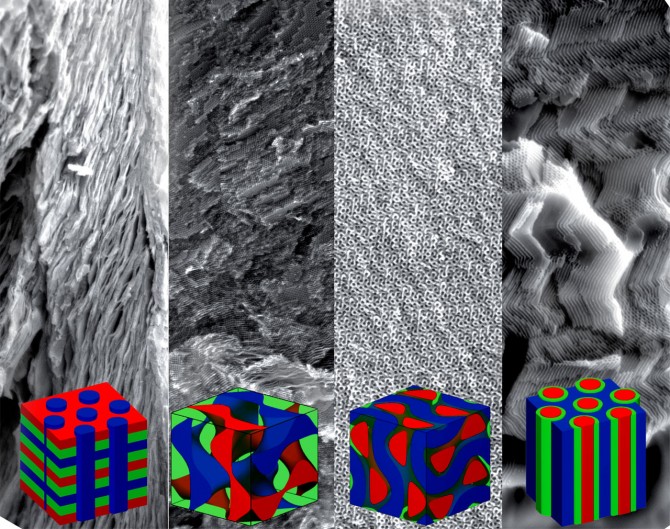Superconducting quantum material has an organic twist
By David Nutt
An interdisciplinary team of Cornell researchers has taken its breakthrough discovery – which melded the ability of soft organic materials to spontaneously self-organize with quantum materials to create superconductors with novel porous architectures – and upped the ante by designing a new cohort of these “quantum metamaterials” that can achieve superconductivity at temperatures competitive with state-of-the-art solid-state materials synthesis.
In the process, they’ve demonstrated the intrinsic superconducting properties are a function of the architecture itself.
The group’s paper, “Superconducting Quantum Metamaterials from Convergence of Soft and Hard Condensed Matter Science,” published May 16 in Advance Materials. The paper’s lead author is Peter Beaucage, Ph.D. ’18.
The interdisciplinary team, which brings together researchers in engineering, chemistry and physics, was led by Ulrich Wiesner, the Spencer T. Olin Professor of Engineering.
“When you look at the regular way that superconductors are put onto chips, it’s all expensive and nonscalable high-vacuum approaches,” Wiesner said. “What we do here is employing low-cost and scalable solution-based processes completely compatible with microelectronics processing. You can basically spin coat these materials onto your chip. You then simply submit them to various heat processing steps, and you get superconductors. And now we know how to get high-quality superconductors.”
The collaboration includes co-authors R. Bruce van Dover, the Walter S. Carpenter Jr. Professor of Engineering; and Sol Gruner, the John L. Wetherill Professor of Physics, and Francis DiSalvo, John A. Newman Professor, Emeritus, both in in the College of Arts and Sciences.
The researchers unveiled their initial self-assembled, three-dimensional gyroidal superconductor, created from niobium nitride, in 2016. The gyroid is a complex cubic structure that contains multiple spirals and pores and allows electronic transport in all three orthogonal directions of space. This was an entirely new architecture for superconductors.
The researchers used organic block copolymer self-assembly to structure-direct a niobium oxide sol into a composite with two intertwining gyroidal networks. After heat treatment in air to remove the polymer and generate a mesostructured and porous gyroidal oxide, the oxide was further transformed into a nitride using subsequent heat treatments in ammonia. By heating and cooling the material in stages up to 850 degrees, the team was able to achieve superconductivity.
“It was a big deal to demonstrate the proof of principle because it showed we can use the structure control on the nanoscopic level from these designer macromolecules and marry that with the properties of superconductors,” Wiesner said. “We now understand this much, much better.”
In the years since their initial findings were published, the researchers discovered that by heat-treating niobium nitride with gases such as argon and carburizing gas, they could achieve high-quality superconducting materials. The niobium nitride becomes more equilibrated, the crystal defects essentially heal, and the quality of the material improves to the point that its transition temperature for superconductivity jumps from the initially achieved 7.9 kelvin to 16 kelvin, comparable to state-of-the-art materials.
By integrating more inorganic sol nanoparticles into the same polymer, the researchers also realized the promise of block copolymers to create other distinct morphologies, or structures, by self-assembly.
While the inorganic lattice parameters of the four structures are very similar, the quantum properties turn out to be different.
“In principle, you think, OK, it’s the same material. So it should have the same transition temperature below which it becomes superconducting. Not true,” Wiesner said. “The transition temperature is actually a function of the mesostructure, not the intrinsic atomic structure of the niobium nitride. That is what’s called metamaterial behavior. If we now imprint those block copolymer mesostructures onto the superconductors, we’re actually going to get completely different properties out.”
Since the process is more cost-effective and scalable than traditional solid-state approaches, the resulting high-quality metamaterials could find use in a range of known or novel applications, such as quantum information science, or energy conversion and storage, or sensing.
“In the beginning, we were crawling,” Wiesner said. “Now, I would argue, we’re walking. We see the street and we’re gearing up to run.”
The research was supported by the National Science Foundation and the U.S. Department of Energy.
The researchers made use of the Cornell High Energy Synchrotron Source and the Cornell Center for Materials Research, both of which are supported by the NSF.
Media Contact
Get Cornell news delivered right to your inbox.
Subscribe

